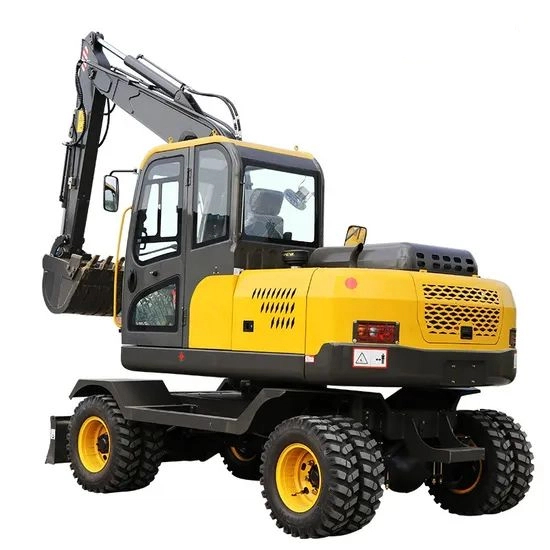As an important type of engineering machinery and equipment, wheeled excavators, with their unique structural design and performance characteristics, demonstrate significant advantages in various scenarios, especially suitable for working conditions that have high requirements for mobility, site adaptability, and operational flexibility. The following details the advantages of wheeled excavators from multiple dimensions:

I. Strong mobility and high transition efficiency
This is one of the core advantages of wheeled excavators, mainly reflected in:
This is one of the core advantages of wheeled excavators, mainly reflected in:
- No need for additional transportation equipment: Wheeled excavators adopt a tire-type walking mechanism and can directly drive on hardened roads (such as highways, factory roads) with a driving speed usually reaching 20-40 km/h, which is much higher than that of crawler excavators (generally not exceeding 5 km/h). For example, when transferring between multiple construction sites in a city, wheeled excavators can drive independently without relying on trailer transportation, greatly saving transition time and costs.
- Adaptability to long-distance movement: For cross-regional small-scale projects (such as rural road repair, multi-village pipeline laying), wheeled excavators can directly drive to the operation site, avoiding the efficiency loss of crawler excavators due to transportation restrictions.
II. Little damage to the road surface and wider application scenarios
- Low ground pressure: The contact area between tires and the ground is large, and the ground pressure is much lower than that of crawler excavators (usually 30-80kPa for crawler type and 10-30kPa for wheeled type). Therefore, when working on paved hardened roads such as asphalt roads, cement roads, and square floor tiles, it can reduce the rolling damage to the road surface, especially suitable for urban municipal engineering (such as sidewalk excavation, green belt transformation) and internal factory operations.
- Protection of sensitive sites: When working in soft-soil farmland, lawns, or protected landscape areas, wheeled excavators are not easy to get stuck in the mud, nor will they shovel up the surface soil like crawlers, which can minimize damage to the working environment.
III. High operational flexibility and convenient operation
- Flexible steering: Most wheeled excavators are equipped with a hydraulic power steering system, with a small turning radius (some models support in-place steering). They can flexibly adjust the working position in narrow sites (such as urban alleys, factory workshops), especially suitable for working conditions with limited space.
- Multi-functional adaptability: Similar to crawler excavators, wheeled excavators can quickly replace attachments such as breakers, grapples, and hydraulic shears. They can not only complete excavation and loading operations but also perform tasks such as crushing, demolition, and material grabbing. Moreover, the stability of the tire-type chassis is sufficient to support the operation needs of various attachments.
- Low operating threshold: Due to the driving mode being similar to that of ordinary vehicles, operators can more easily adapt when driving during transitions. In addition, when working on flat roads, the body vibration is small, and the operational comfort is better than that of crawler excavators.
IV. Lower maintenance costs and more economical use
- Simple maintenance of the walking system: The maintenance cost of tires is much lower than that of crawlers (components such as crawler plates, track links, and drive wheels of crawler excavators wear quickly and have high replacement costs). The tires of wheeled excavators only need regular inspection of tire pressure and wear conditions, have a long replacement cycle, and are easy to repair, which can be operated by ordinary maintenance personnel.
- Relatively low fuel consumption: When driving on highways or working under light loads, the fuel consumption of wheeled excavators is usually lower than that of crawler excavators of the same tonnage, which can save fuel costs in long-term use.
V. Few regulatory restrictions and more freedom in operation
- Relaxed road driving permissions: In most areas, wheeled excavators can go through temporary road access procedures and legally drive on public roads; while crawler excavators, as "non-road mobile machinery", need to go through complex over-limit transportation permits to get on the road and are usually prohibited from driving on main roads.
- Few restrictions on operations in urban areas: The core areas of cities often have strict time or route restrictions on the use of crawler machinery (such as avoiding operations during morning and evening peaks, prohibiting stopping on main roads). Wheeled excavators, due to their little impact on the road surface, can more easily obtain operation permits.
Summary of applicable scenarios
The advantages of wheeled excavators make them perform particularly well in the following scenarios:
The advantages of wheeled excavators make them perform particularly well in the following scenarios:
- Urban municipal engineering (such as pipeline excavation, road repair, greening arrangement);
- Rural road construction, farmland water conservancy transformation;
- Material handling and site cleaning inside factories;
- Small and medium-sized projects with frequent short-distance transitions;
- Areas with high requirements for road surface protection (such as scenic spots, campuses, residential areas).
Of course, wheeled excavators also have limitations (for example, their passability in complex terrains such as muddy areas and steep slopes is not as good as that of crawler excavators). However, in suitable scenarios, the above advantages can significantly improve operational efficiency and economy, making them an important choice in engineering construction.





